
Pay-Per-Click (PPC) advertising campaigns are often one of the most vital ingredients of a successful student recruitment strategy. PPC initiatives can help your school improve its reach in crucial regions you want to break into, test the potential of new keywords and target markets, and even strategically remarket to existing leads who have shown interest in your school but failed to follow up. Not only that, but since you only pay when a potential lead clicks on your ad, paid search campaigns can be incredibly cost effective, and easily tailored to the budget of even the smallest school.
But how you can you be sure your school is getting the most out of your PPC initiatives? Are you currently devoting your entire PPC budget to Google AdWords, when other channels would achieve better results? What can social media PPC offer your school, and which platform is most likely to help you connect with real prospects in your institution’s target market?
Read on to find out about some of the advantages and disadvantages of different PPC options, and how schools can streamline and refine their PPC initiatives to increase their ROI.
Google AdWords is Still Essential in PPC for Student Recruitment
The most commonly used and well-known PPC platform, Google AdWords is usually the natural first port of call for many higher education paid advertising campaigns. The internet search giant estimates that its ad services reach over 90% of the internet, and their PPC formats include paid search ads, display advertising, ads in apps, and even video ads which are run through YouTube.
The sheer size of Google’s potential audience makes it essential for schools to devote at least some of their PPC efforts towards AdWords. Even if you are lucky enough to enjoy excellent organic SEO and overall online presence, failing to invest in PPC can allow your competitors to slowly erode your position.
Example: These are the top PPC ads on a Google search for ‘MBA USA.’ As you can see, even top universities such as Cornell and McGill invest heavily in PPC campaigns.
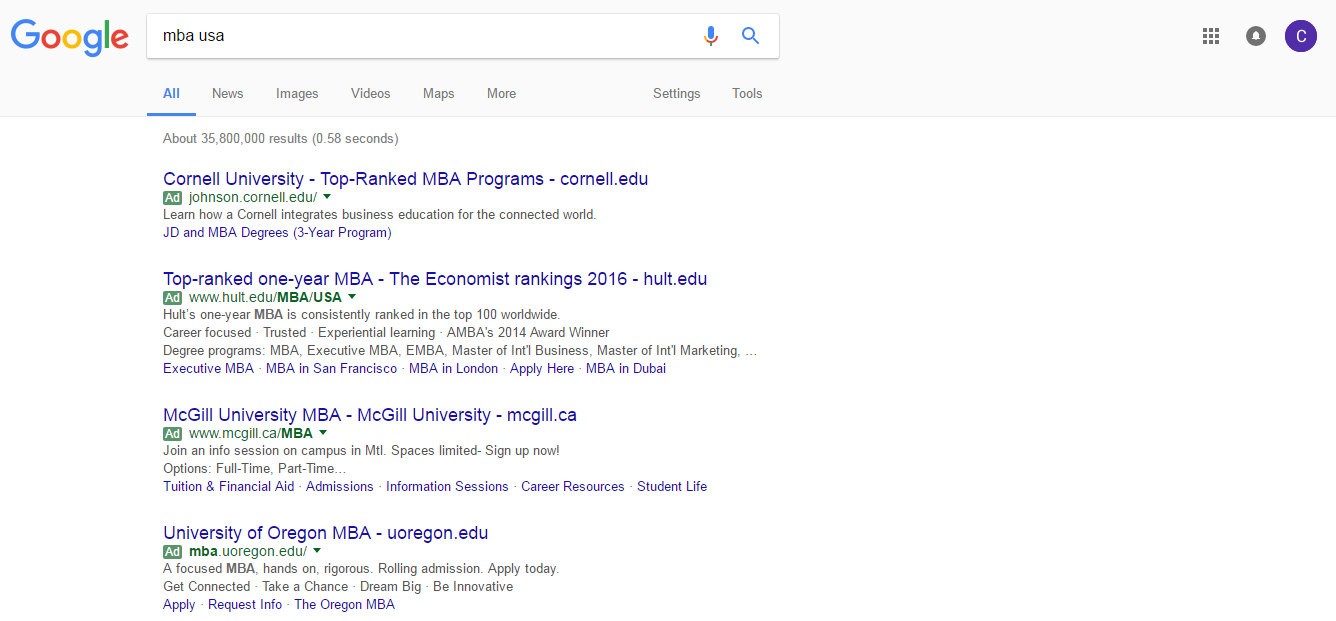
However, while Google AdWords offers incomparable reach, schools are also likely to face stiff competition to have their ads seen on relevant websites or the most sought-after search engine results pages (SERPS), and this often means paying a high price to secure a good position. For example, the average Cost-Per-Click (CPC) for ‘MBA’ has risen from around $4 in 2010 to over $60 today.
Nonetheless, AdWords can still be very cost-effective when managed correctly. Proactively monitoring the budget and run time of your campaigns can help ensure they achieve the right results, while it’s also essential to link your AdWords account to your Google Analytics setup, which will allow you to analyze the entire customer journey to see which campaigns are seeing real returns for your school.
Why Include Bing in Your Higher Education Paid Advertising Strategy?
Microsoft’s Bing search engine is often overlooked, which could prove to be a big mistake as we head into 2017. Bing’s market share has been slowly growing for some time, and exceeded 20% in both the UK and the USA last year.
Part of the reason for the growth has been the release of Windows 10, which adopted Bing as the default search engine for both its desktop search and its Cortana voice search tool. As the new platform becomes standard across more and more computers, Bing could gain an even bigger audience.
The Bing Ads platform is broadly similar to Google’s, but there are a number of differences. Some of the most notable include:
- Sidebar ads– Google controversially removed PPC ads from the sidebar of their SERPs in 2016, but Bing still includes it, which allows the site to display more ads per page:
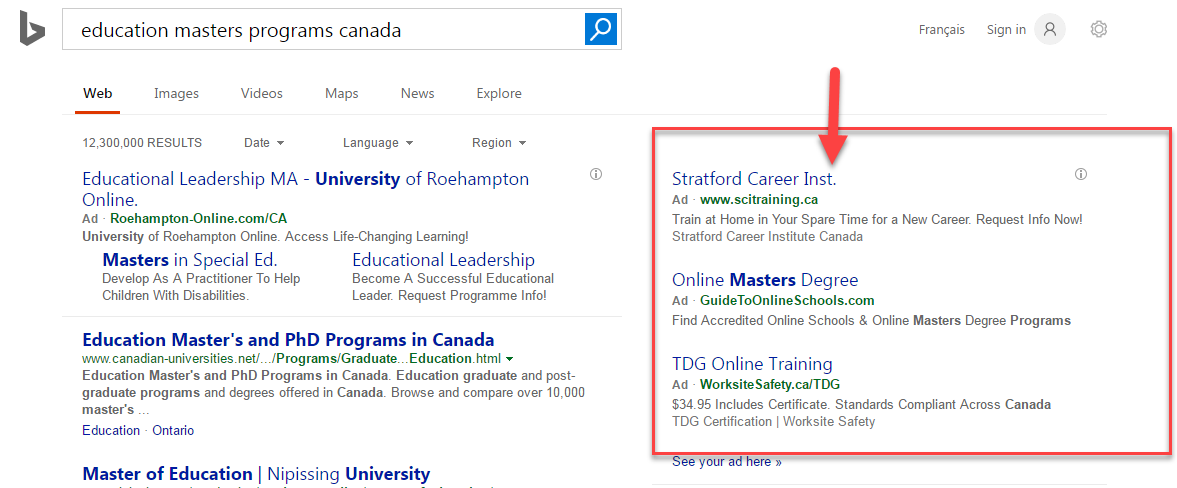
- Better Granular Targeting– Both platforms allow you arrange ad groups into campaigns, but in Google all settings need to be managed at campaign level. Bing allows settings such as location targeting and dayparting to be set at ad group level, making it easier to customise your settings for specific ads.
- Image Extensions- This is a new feature Bing recently introduced which allows you to display up to six images alongside your ad. Google had previously tested image extensions in 2013, but the project never got out of the beta stage. However, Bing feel they have addressed the issues which saw Google’s version fail, and the CTR increases the company claims the feature will bring are certainly impressive:

Bing’s smaller market share can also have some strategic benefits, as bidding on certain keywords can sometimes be cheaper than on Google, although this is not always the case. In fact, Microsoft’s Christi Olson recently revealed that education was among the most competitive fields in Bing’s keyword verticals last year:
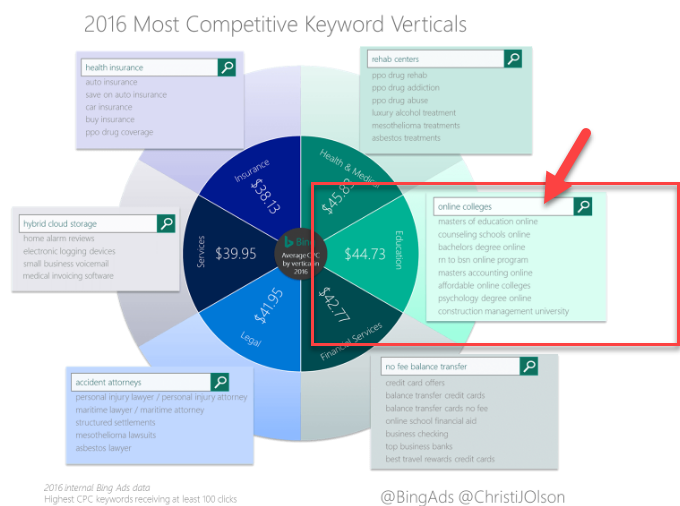
Bing’s detractors also note a few drawbacks it offers when compared to AdWords, such as less efficient reporting, a slower interface, and an inferior functionality when it comes to remarketing. The biggest disadvantage of Bing, however, is its limited reach. Schools looking to assess the worth of using the platform for PPC campaigns should carefully examine their target audience’s behaviours to figure out how likely they are to use Bing. As a starting point, this is how Bing itself currently estimates the age range of its US audience:
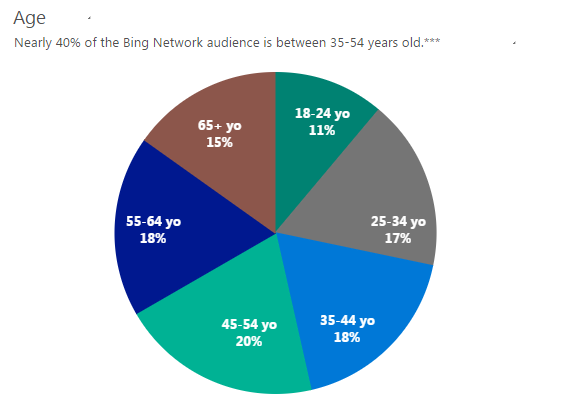
As you can see, Bing users are generally slightly older than Google users, suggesting that schools targeting mature students or marketing towards parents may be more likely to see results from the platform.
Nonetheless, experimenting with including Bing in your strategy could be beneficial for schools at a number of levels, particularly as its market share continues to increase. Monitoring your campaigns closely will quickly give you an idea whether you are reaching your intended audience through the network.
Using Baidu for PPC for International Student Recruitment in China
Both Bing and Google offer great potential options for PPC campaigns in many countries, but for those looking to recruit in China, the leading market for international students, a different strategy is required.
As many recruitment professionals know, Google and all its services are banned in the country, and while Bing and Yahoo do enjoy some popularity- particularly for searches and English and other non-Chinese languages- being visible on Baidu, China’s leading search engine, is essential to reaching prospective students in the country.
Baidu’s advertising platform– known as Baidu Tuiguang- offers many of the same features as Google AdWords and Bing Ads, including a similar PPC account structure, access to a comprehensive display network, and its own analytics tool, Baidu Tongji, which is conveniently linked automatically to your Tuigang account.
Like Bing, Baidu displays ads on the top, bottom and right hand side of its SERPS, and offers advertisers a number of different formats. An image can be added to your ad at no extra cost, and the Baidu Business Bridge software extension even allows brands to include a button in their PPC adverts which enables users to start an immediate online chat with one of your representatives from the SERP.
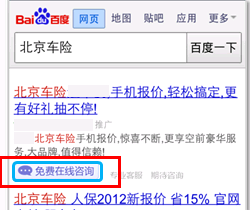
Baidu pages also sometimes include Brand Zone ads, a premium option which allows brands to take over both the top and right hand side of the page with sophisticated ads that incorporate images, video, and other elements.
However, brand zone ads are charged on a cost-per-time basis rather than CPC, meaning users have to pay monthly, and the service can be quite expensive. As a result, it is not really used by schools and more common among large corporations like BMW, although a scaled down version of the feature, know as brand landmark, is available for smaller operators.
One feature of Baidu PPC which could interest schools is Baidu Jiaoyu, which is the company’s dedicated education platform. It provides a specialised search option for users looking for both online and physical courses, and allows institutions to advertise using specially structured ads, which can include details about specific courses. Results from Jiaoyu also show in Baidu’s main search results pages, making it well worth checking out for schools interested in multi-lingual PPC for international student recruitment in China.
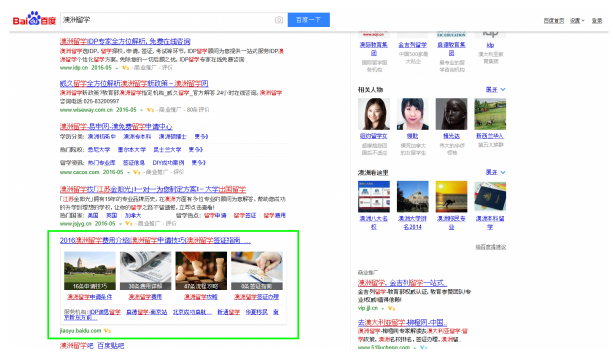
Source: nanjingmarketinggroup.com
While Baidu Tuigang has its positive attributes, there are a few features you might miss if you are used to managing campaigns from AdWords. Baidu’s filtering and segmentation capabilities have historically been more limited, although this is changing with the introduction of the site’s ‘People Targeting’ feature last year, which allows you to target users based on their interests and search behaviours.
In addition, unlike AdWords, Baidu doesn’t allow just anyone to set up an account, and schools looking to start using Baidu for PPC will need to do so through an approved agency. Baidu PPC users are also required to have a fully functional Chinese language website.
The Advantage of Social Media PPC for Student Recruitment
While paid search campaigns are a common starting point for many schools, social media PPC campaigns can also offer a number of great options for schools looking to generate more inquiries.
The key difference between PPC for student recruitment on social and search is targeting. Social media sites allow you to segment your audiences far more precisely, taking into account their location, age, interests and many other factors. As a result, conducting PPC campaigns on social media can often make it easier to find good prospective leads, and even result in a lower cost-per-click than paid search.
However, PPC on social media can take longer to produce a return. Since paid search targets users who have searched for a particular term, any leads generated from those campaigns are likely to be further along in the enrollment journey, as they are actively looking for what you have to offer.
Social media PPC leads, on the other hand, are not necessarily looking for courses when they are being shown your ad. As a result, schools tend to use social PPC for engaging prospective students at the awareness stage of the process in the hopes of encouraging more serious interest down the road, or for remarketing to lapsed leads.
Most social networks now offer PPC advertising options, and choosing the right option for your school will depend on the demographics of your target audience. Facebook Ads are by far the largest social media PPC network. Using the social media giant’s ad editor, you can create PPC campaigns for both Facebook itself and its photo-sharing subsidiary Instagram, allowing you to cover two of the largest social platforms in one. Both offer a range of different options for ads including images, video, carousel, and slideshow formats, each of which are visually engaging and more versatile than paid search formats.
Social PPC ads also offer a greater variety of different CTAs, and schools can use their Facebook and Instagram ads to encourage users to like their page, direct them to their website or a specialised landing page, or even link the ad directly to Facebook Messenger.
Example: This is a typical Facebook Ad from Yorkville University, which illustrates the many different engagement possibilities ads on the platform offer. Users who are shown this advert can click on the ‘learn more’ CTA button which redirects to the school’s website, like Yorkville’s Facebook page, or like, comment and share underneath the post.

Other social networks also offer their own PPC options. LinkedIn’s PPC service allows you to target the site’s users by age, profession, and even by employer. While this won’t necessarily be appropriate for schools looking to target undergraduate students, it could be a very useful lead generation tool for any institution offering programs related to professional development, or postgraduate options such as MBA degrees.
Example: This well-targeted ad from McMaster and Syracuse University for their Master of Communications Management degree shows up in a LinkedIn search for ‘MBA marketing.’

Twitter also offers a unique proposition for schools, and serves almost as a halfway house between search and social PPC. The site’s ad platform allows you to target users who search for and use specific hashtags. The topical, news driven nature of the platform makes this an intriguing prospect for schools that can use their ingenuity to build campaigns around important events such as application deadlines. For example, a school in the UK could build a campaign around the ‘#UCAS’ hashtag in order to target students applying to university through the UCAS system.
Finding The Right PPC Option for Your School
Whichever of these options you feel is best for your school, it’s best to focus on a few different channels. Having a diverse PPC strategy will enable you to increase your online visibility more effectively, engaging prospects in all your target markets and regions and boosting your chances of conversion by taking a greater variety of different approaches.
Of course, monitoring and managing your campaigns well will make all the difference to your success. Carrying out comprehensive keyword research, a/b testing, and continuously measuring your campaigns using analytics are all crucial components to ensuring you achieve the best possible ROI. But with well-defined goals and a focused approach, PPC can be one of the most worthwhile investments your school can make.
What channels do you use for your PPC campaigns? Leave a comment below and tell us about your experiences!







